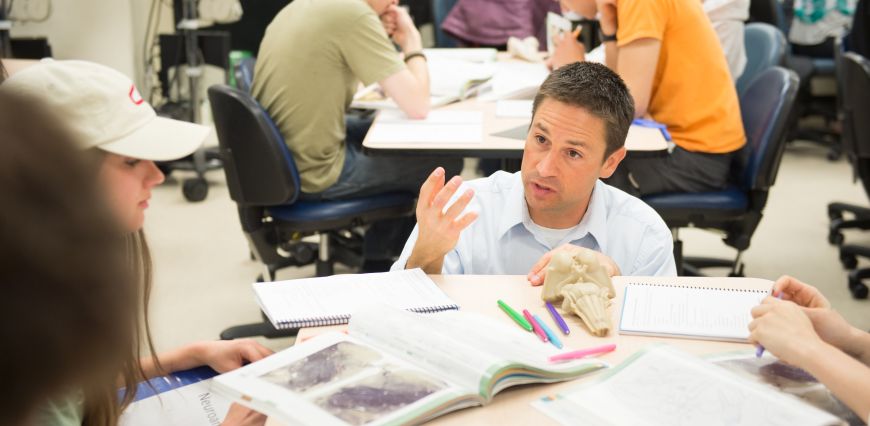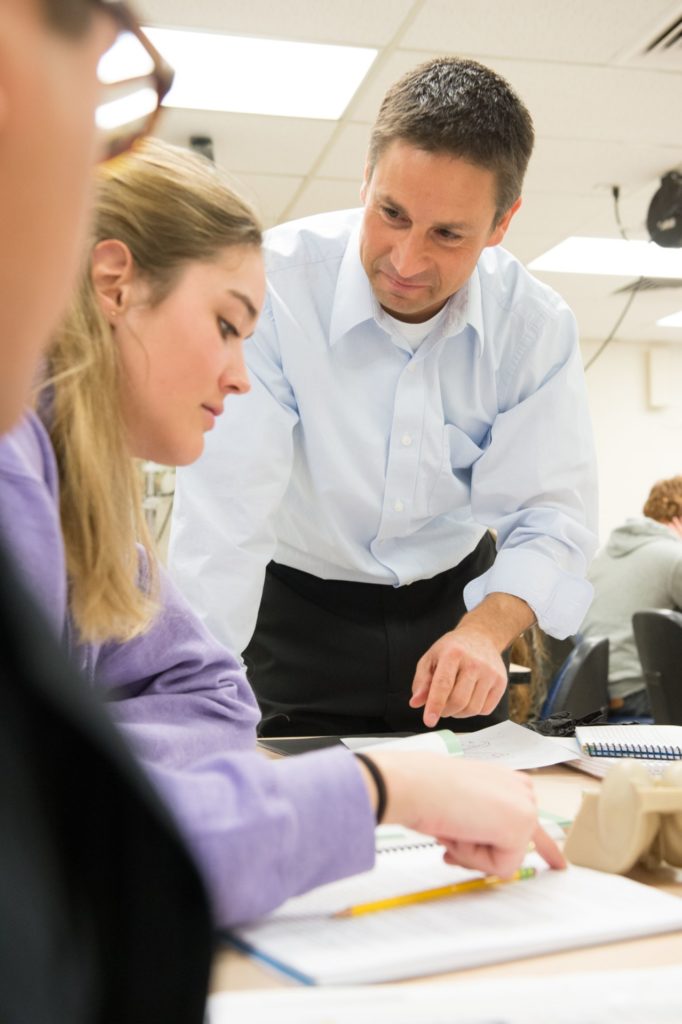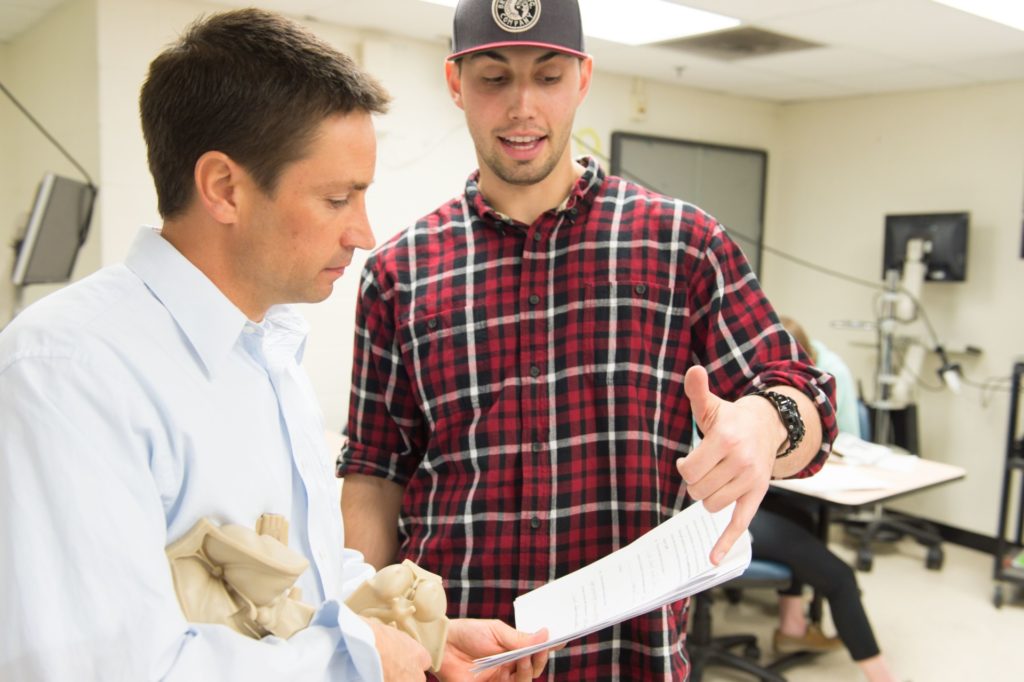
Above: Tod Clapp, an assistant professor in Biomedical Sciences, discusses the human thalamus and brainstem during a neuroanatomy class.
There’s a quote familiar to all of Tod Clapp’s students: “The world isn’t interested in the storms you encountered, but whether or not you brought in the ship.” – Raul Armesto
“My students are so sick of that one, but I say it all the time,” said Clapp, an assistant professor in the Department of Biomedical Sciences. “It’s all about taking responsibility.”
His philosophy helped Clapp earn a 2016 Best Teacher Award from the CSU Alumni Association, which presented the coveted honors April 18. Clapp was among six recipients this year, and he became the sixth faculty member honored in the College of Veterinary Medicine and Biomedical Sciences.
Clapp teaches human anatomy and neuroanatomy courses – acclaimed CSU programs that form a critical foundation for students pursuing entry to medical school and a wide range of careers in research and human health. In addition to teaching, Clapp oversees the human anatomy curriculum, directs and advises students in the department’s Master of Science program, serves as an honor’s thesis advisor, and heads anatomy outreach for K-12 students.
Nominators praised Clapp for his warm personality, sense of humor, and ability to engage, motivate and connect with students. Clapp encourages students to take responsibility for their educations with captivating lectures, contagious enthusiasm and high expectations, student nominators wrote.
“Dr. Clapp brings a breath of fresh air to higher education,” one graduate student wrote.
Here, he answers questions about his work with students.
What do you most love about your job?
Dr. Clapp: I love the team I get to work with. One of the best things about the human anatomy program at CSU is the dedication everyone has to using real human specimens, which not many other places have. Human cadavers require a lot of work, and everybody on our team is dedicated to maintaining these resources because we all believe that studying cadavers is hugely beneficial. There’s quite a bit of data showing that studying human anatomy with cadavers provides better learning outcomes than with digital programs alone. We are very lucky that our administration supports that because I believe it’s one more thing that makes CSU really unique.
Dr. Tod Clapp
Title: Assistant Professor in the Department of Biomedical Sciences
Education: B.S., 1996; M.S., 1999; Ph.D., 2004. All from Colorado State University.
Courses taught: Human gross anatomy; honors human gross anatomy; supervised college teaching; human anatomy dissection; advanced human gross anatomy; managing a career in science; functional neuroanatomy; understanding neuroanatomy through clinical case studies.
Previous honors: The Water Pik and CSU Athletic Department Excellence in Education Award; the Outstanding Academic Advising Award in Graduate Education, College of Veterinary Medicine and Biomedical Sciences; the Lisa Marie Craft Memorial Graduate Scholarship for career promise in teaching.
Family: Tod and his wife, Terra, a nurse anesthetist, have a daughter and son.
Hobbies: Playing fastpitch softball, mountain biking, and wakesurfing.
Why study anatomy?

Dr. Clapp: Anatomy is the foundation for all medicine and health-related fields. But here at CSU, we want to encourage everyone to take anatomy, not just pre-medical students. Every student at CSU, whether they’re studying science, English, engineering or business should have some background in anatomy so that they can learn how to speak intelligently with a physician. It’s part of a comprehensive, broad undergraduate education and is applicable to everyone.
What has been your favorite class or lecture to teach?
Dr. Clapp: My passion is neuroanatomy. There are very few institutions that offer a true neuroanatomy course, and CSU is one of them. There are a lot of circuits, and it’s a difficult system to learn, which can be intimidating to students. But it’s a system that makes sense, and I love when it starts making sense for the students. When students start to understand the “why” behind it, learning it becomes fun for them. And one of my favorite topics to lecture on is the vestibular system because it demonstrates the amazing things the nervous system is capable of.
You’ve been praised for having a unique teaching style that motivates students and engages every type of learner. How do you do that?
Dr. Clapp: When new students come in, I ask them: “What do you want to leave CSU with?” Most have not thought about this and do not have an answer. So, we suggest to them that they think about wanting to leave CSU with the ability to solve a novel problem. In general, students struggle with this and aren’t given enough practice with it. In our classes, we present students with a problem they haven’t seen before and encourage them to ask themselves questions they can answer that will lead them down a path toward solving it. For example, at the beginning of most of my classes, I ask my students: “Where do you put a windmill?” and the students reply, “Where it’s windy.” But when I ask that question on the first day of class, it’s apparent that most students are used to trying to come up with memorized answers. This exercise teaches them to back up and see the big picture. The next question would be, “Where is it windy?” And so on. The real fun happens when students apply this strategy in other classes and see it work for them.
What’s your best piece of advice for students?

Dr. Clapp: I always tell my students: “This is on you. You need to get what you want out of this class, and what you want out of this class isn’t points. You don’t show up to get points, so who cares if this will be on the test or not? What’s important is that you understand it.” They get sick of me saying that, but I say it virtually every day. I think students enjoy applying what they learn, and they appreciate being told, ‘Hey, this is going to be a tough challenge—good luck.’”
What do you like to do when you’re not working?
Dr. Clapp: I get outside whenever I can. I love to mountain bike in Curt Gowdy State Park, play and coach fastpitch softball, and wakesurf on Horsetooth Reservoir and Boyd Lake.
Previous recipients
Each year, students and alumni nominate outstanding educators for Best Teacher Awards. Honorees are selected by a committee of faculty, students and members of the CSU Alumni Association Board of Directors. Clapp is the sixth faculty member from the College of Veterinary Medicine and Biomedical Sciences to be named a Best Teacher. Previous recipients in the college include:
- 1997, Dwight Bennett, veterinary medicine
- 1998, Mark Frasier, human anatomy
- 2002, Erica Suchman, microbiology
- 2008, John Walrond, human physiology
- 2015, Marie Legare, toxicology